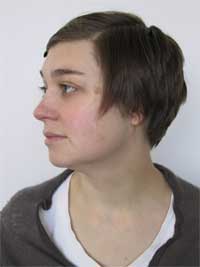 A few weeks ago, i went to Newcastle for the opening of the Picture House exhibition. It was at least minus 37 degrees up there and i was walking from one room of Belsay Hall to the other, watching the installations and following a girl with a nice bag that sported a funny phrase in crooked french. I still don’t know if it was the bag or the girl i was stalking but i ended up having dinner with her under a (non-heated) tent. Anyway the girl with the funky bag was in fact Sarah Cook , researcher, co-founder and co-editor of CRUMB (the Curatorial Resource for Upstart Media Bliss), an online resource for curators, producers, commisioners and exhibitors of new media art. Sarah is also a post-doctoral research fellow at the University of Sunderland (England) and an independent new media curator. She has organized exhibitions, commissioned new media art and managed educational projects for BALTIC, Gateshead; Bellevue Art Museum, Seattle; Walker Art Center, Minneapolis; Banff New Media Institute; Reg Vardy Gallery, Sunderland; Locus+, Newcastle; etc. Oh! and she did an interview of me, should be online soon here.
A few weeks ago, i went to Newcastle for the opening of the Picture House exhibition. It was at least minus 37 degrees up there and i was walking from one room of Belsay Hall to the other, watching the installations and following a girl with a nice bag that sported a funny phrase in crooked french. I still don’t know if it was the bag or the girl i was stalking but i ended up having dinner with her under a (non-heated) tent. Anyway the girl with the funky bag was in fact Sarah Cook , researcher, co-founder and co-editor of CRUMB (the Curatorial Resource for Upstart Media Bliss), an online resource for curators, producers, commisioners and exhibitors of new media art. Sarah is also a post-doctoral research fellow at the University of Sunderland (England) and an independent new media curator. She has organized exhibitions, commissioned new media art and managed educational projects for BALTIC, Gateshead; Bellevue Art Museum, Seattle; Walker Art Center, Minneapolis; Banff New Media Institute; Reg Vardy Gallery, Sunderland; Locus+, Newcastle; etc. Oh! and she did an interview of me, should be online soon here.
You co-edited the book Curating New Media in 2002. Has the panorama evolved a lot since you wrote that book? Are new media curators still facing the same challenges?
That book was the result of a three-day conference CRUMB organised in Newcastle/Gateshead in May 2001 and in retrospect might be considered the first such meeting of curators and producers of new media in the UK (it resulted in at least one marriage and baby!). At that time we were talking a lot about net-based art and how museums such as the Tate were commissioning artists to make work for their websites (in part because there was a dearth of venues for media art in the UK). We had curators with backgrounds in film and video (who were defining themselves as moving image or lens-based art curators), debating with commissioners from the Science Museum who were interested in interactive installations, debating with sound artists and net-artists who were just trying to get their work commissioned fairly. So while there were disciplinary boundaries to overcome, there were fundamental concerns which affected everyone up for discussion: funding, audiences, institutional support, and professional development.
Curators are still facing a lot of the same challenges today – what is this new art, who is making it, where do I find it, how do I install, collect or preserve it? – but their self-definition is helped by the fact that the landscape of art exhibition has changed and become more multifaceted. For new media art it’s not just a question of whether to show it ‘on the web or not’ anymore (Though getting the Tate to realise that is still a challenge as I understand from the curators there). Art is now exhibited in spaces and places other than white cube galleries – from science museums to media museums to festivals and even airports. The web has changed enormously too, so what we might have thought of as net-art then we might think of as research or social networking today. Curators understand that some work uses the web but doesn’t result in a project that is solely exhibited on the web (it might have a physical component to it too). Artists, as usual, are using whatever medium necessary to realise their work and curators should be responding to that, no matter what their backgrounds may be.
How optimistic are you about the near future of new media curating? Do you see things of positive (and fast) changes?
 CRUMB has organised a few workshops for new media curators which have taken the form of ‘crisis centres’ playfully suggesting that there are deep tensions at the heart of new media curatorial practice, most of which can be partially relieved by a good chat over a nice cup of tea. [For the Enter Festival in Cambridge in April we ran a ‘Bliss Out Centre’ with Indian Head Massage, Open Source Embroidery – courtesy of Ele Carpenter – knitting, fortune teller games and other activities.] These tensions usually are from uncertainty about definitions of the art but also of the curatorial practice. What is the role or value of a curator in the age of ‘user-generated content’, to be only a filter or editor? How do the other seemingly invisible skills curators have – about dealing with the press, being the interface between the art and the audience – get supported? How do you learn the necessary skills to engage in the production of publicly sited art? I think curatorship, as a field of practice, is quite slow to evolve (certainly slower than the art is changing), and mostly because it is only in the last 15 years that curatorial practice has become reflexive (and some argue, overly so). But this is predominantly in the field of independent or freelance curating, which I am optimistic about. For instance in the way curators might evolve their social networking skills based on how we live and work on the web today, and therefore make their curatorial process more open, more collaborative (though does that result in better shows? Not always).
CRUMB has organised a few workshops for new media curators which have taken the form of ‘crisis centres’ playfully suggesting that there are deep tensions at the heart of new media curatorial practice, most of which can be partially relieved by a good chat over a nice cup of tea. [For the Enter Festival in Cambridge in April we ran a ‘Bliss Out Centre’ with Indian Head Massage, Open Source Embroidery – courtesy of Ele Carpenter – knitting, fortune teller games and other activities.] These tensions usually are from uncertainty about definitions of the art but also of the curatorial practice. What is the role or value of a curator in the age of ‘user-generated content’, to be only a filter or editor? How do the other seemingly invisible skills curators have – about dealing with the press, being the interface between the art and the audience – get supported? How do you learn the necessary skills to engage in the production of publicly sited art? I think curatorship, as a field of practice, is quite slow to evolve (certainly slower than the art is changing), and mostly because it is only in the last 15 years that curatorial practice has become reflexive (and some argue, overly so). But this is predominantly in the field of independent or freelance curating, which I am optimistic about. For instance in the way curators might evolve their social networking skills based on how we live and work on the web today, and therefore make their curatorial process more open, more collaborative (though does that result in better shows? Not always). 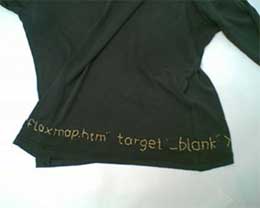
I suppose I am less optimistic about institutional curatorial practice as far as new media art is concerned, but only because art museums are themselves in a state of crisis and are dealing with it by moving away from having curators with any form of subject specialties at all (resulting in the cancellation of experimental programs or the closing down of departments – look at MoMA with its Media Department which is focused on video installation). If new forms of art aren’t getting collected and well documented and written about or shown, then the depth of knowledge of the mainstream art curators who have to be generalists and have knowledge about everything is going to be limited (to what is written about in magazines, and to what they see when they go to the big art fairs). This means they might not be able to respond easily to the exciting projects that challenge the structures of the art museum or challenge the idea of what art is. Sorry, this is becoming a big long chew of a mouthful of an answer.
What do you think are the elements that hamper the integration of new media art pieces in museums?
In art museums I think a lot of the resistance to new media art has to do with the traditional ways of judging and valuing art – new media art isn’t always an object (it’s a process or event), it isn’t always unique (it’s easily reproduced or made collaboratively, sometimes, god forbid, by the audience participating!), it therefore isn’t always collectable (it can be ephemeral data or code) or even predictable as to what it will be. And it plugs in, so could break down, and that scares curators who are trained to put on exhibitions of unchanging, static objects.
I get bummed out having to write answers like that one above because while I know a lot of that is to a certain degree true, I also think good curators will be able to look to art history and say, but wait, conceptual art is ephemeral, live performance art is a time-based, interactive process which can’t be collected, and still we have long histories of supporting that! Good curators look for the balance between form and content, and don’t get hung up on the form or, in the case of new media art, the technology. That said, you do have to know something about the form – enough to know why it might be significant for this particular work of art, or at least to know what you don’t know!
I have had directors of museums tell me that they don’t believe there is an audience for new media art, certainly not enough of an audience to warrant what they perceive to be an overly costly investment in it (“It costs £7.00 per head to put on a live media art event here and I’d rather give them £10.00 each and tell them to stay away!” one director had the gall to say to me). And I’ve had other art gallery directors say to me, “We don’t show new media art because I haven’t seen anything that I think is very good” when they are sitting next to the artists whose show they’ve just opened whose CVs include winning prizes at the Venice Biennial and only working with digital video or immersive and responsive sound environments. Hello?! Neither would admit they haven’t seen very much new media art, or don’t know where to look, or even what it looks like.
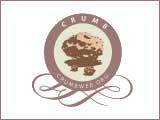 So that’s art museums, but your question didn’t specify. In Science museums and Media museums it seems to me as though the integration is less hampered, perhaps because the curators there are less afraid of the form. Some of the only permanently installed, commissioned new media works on view in London are in the Science Museum – perhaps because part of their remit is to engage in technological culture. The new British Film Institute Southbank venue has a gallery which is capable of showing all forms of interactive, immersive, responsive, data-driven new media art; though whether they’ll show anything more than film and video installation remains to be seen.
So that’s art museums, but your question didn’t specify. In Science museums and Media museums it seems to me as though the integration is less hampered, perhaps because the curators there are less afraid of the form. Some of the only permanently installed, commissioned new media works on view in London are in the Science Museum – perhaps because part of their remit is to engage in technological culture. The new British Film Institute Southbank venue has a gallery which is capable of showing all forms of interactive, immersive, responsive, data-driven new media art; though whether they’ll show anything more than film and video installation remains to be seen.
Your webpage says that you are a curator of contemporary art. Your practice is mainly concerned with new media art. Do you regard new media art as a distinct entity or would you rather see it as “just” another form of art?
I’ve worked in museums and galleries of contemporary art and feel comfortable in each world. My background is in philosophy, modern history, contemporary studies, not art history. I think it’s funny two of my degrees have the word contemporary on them, written in Latin, loosely translated as Aetatem recentissiman pertinentibuss as there is no actual word for “contemporary studies” in Latin – there is only ‘pertinent to the recent time’ studies. So for me new media art is the most ‘pertinent to the recent time’ art. New media art IS art (not JUST art) and as an ever-changing field of practice it has the potential to completely redefine what art is, just as it might redefine what new is, or what media is.
What are the conditions required to achieve “upstart media bliss”?
Tea and cookies and wifi? As a curator, keeping up with the times but not “dancing the novelty hustleâ€? (as Barbara London has said); having a sense of history is important. Challenging the system – be it the art system, the museum, or the format of the exhibition – and not being afraid to take a risk (generally being an upstart). At the same time, remembering to take care of the artist and the work, take care of other people and your ethics. Creating situations for contemplation and reflection (bliss doesn’t have to be monumental, it might only last a minute, but a minute worth remembering).
If you could teach new media art bloggers one thing, what would it be?
To inspire others to do what they do. Because I think there is room for a lot more of them than there are now. I’d like some of them to be more rigorous and critical. To get their work published in non-new-media print magazines, newspapers, and journals, or to take those established formats on at least.
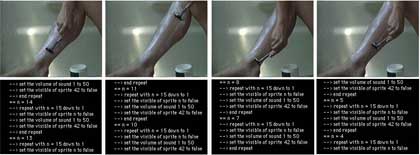 Natalie Bookchin’s Databank of the Everyday, part of Database Imaginary
Natalie Bookchin’s Databank of the Everyday, part of Database Imaginary
I’ve always loved the title of an exhibtion you co-curated with Steve Dietz, “The Art Formerly Known As New Media.” That was a provocative title (I think). Which kind of discussion were you hoping to raise with such title & exhibition? Did a debate take place as you expected?
The curatorial remit for that exhibition was to look back across ten years of activity at the Banff New Media Institute in Canada, and so expectations were that we might curate some kind of ‘best of’ retrospective. Steve and I weren’t as interested in that mode of exhibition making as we were in choosing works which might redefine for us what ‘new media art’ is, or what art is in the age after new media, if indeed we are in such an age. We looked at the work of hundreds of artists who had ever been to a new media event at Banff and asked many of them what they were doing now. We considered some of the big themes which had recurred in the discussions at Banff – artificial intelligence, the body and biological matter, data visualisation, social networks, identity, memory, interactivity – and thought about art works in relation to those.
The title caught people’s attention, though I’m not sure the show generated much debate (except perhaps over the way we installed the work of irational.org). It coincided with Re:fresh, the (so-called) first conference on the histories of media art and science, and I think the historians who attended might have liked to have seen a ‘best of’ retrospective after all, which would have been nice, but to us it didn’t feel like the right mode to work in. Steve and I, with Anthony Kiendl, had before that curated the exhibition Database Imaginary, and so we were still asking questions like ‘what is this thing called newness?’ or ‘what is the behaviour of these works in relation to me?’ or ‘what does this work of art tell me about the ‘postmodern condition’ or the informational-technological world I live in?’ We hope people who saw that show (and you can still buy the t-shirt if you want!) left asking similar questions.
Together with Sabine Himmelsbach, you curated the exhibition “My Own Private Reality” at the Edith Russ Haus for Media Art in Oldenburg (Germany.) The works selected reflect the phenomenon of social communities on the Internet and its democratisation. What is your view on these issues? Critical? Openly enthusiastic?

I have what could be called an irrational aversion to the myspace.com ‘phenomenon’ because (of Murdoch but also because) I have what could be called a nostalgic snobbish adherence to earlier, better made, smaller, smarter versions of just about everything (depending who you ask I’m either old before my time, criticising that ‘they don’t make them like they used to’ or I exhibit the all-consuming enthusiasm and desire of the early adopter). I think that some so-called web 2.0 technologies are the corporate world’s way of creating dependent consumers and thereby discouraging alternative peer-to-peer computing from flourishing. Which is why I love Cory Arcangel‘s work BlueTube which just serves to remind viewers of the infrastructure which they so mindlessly meld in to. But I equally believe that these softwares (and especially the open source ones, which allow you to learn a little, and share, and to move beyond the generic template) make possible meaningful activity, through the social communities they encourage, which deserves a look in. It is interesting to see how having an alter-ego online, being a part of a community on the web, has come full circle – from in the early 90s putting yourself online, to in the late 90s and early 00s being someone else online, or someone you can’t be in your offline life, and now in the late 00s to a mix of those modes. Being part of an online social network is now an enhancement of your offline life. People are still learning the nuances and social manners and etiquette of this new hybrid existence.
I think curating is about challenging yourself and your beliefs, assumptions, and contradictions, so that’s a reason I took the approach I did. I also wanted to curate this show because I knew of a lot of great art projects which are about the using the web to talk about the social impetus in all of us and I wanted the chance to think about that work all together in a space – works which embody both of my views on the technology itself. Working with Sabine and her team at the Edith Russ Haus was fantastic; it’s so vital to have spaces like that in the world where there aren’t the pressures of a museum collection to maintain or enormous spaces to fill and instead there are artists in residence making new work for consideration (in our case Hans Bernard/Ubermorgen and Annina Rust).
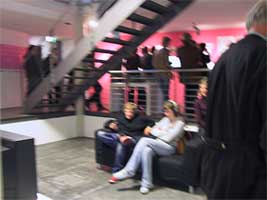
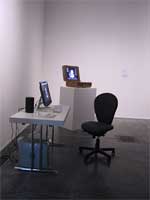 My Own Private Reality (more images)
My Own Private Reality (more images)
How does one get to be like you, an internationally-esteemed curator of new media art?
Well, gee, hmmm. Having a degree from a curatorial programme (in my case Bard College) and working in esteemed institutions (The Walker Art Center; The National Gallery of Canada) helps gets the ball rolling. Then having a full-time research post at a University that is supportive of your freelance curatorial work (Thank you University of Sunderland) is invaluable. Otherwise, I’d suggest that you find good people to collaborate with and learn from them (Thank you Steve Dietz). Try and be in the right places at the right times (Thank you Sara Diamond and Susan Kennard and the Banff New Media Institute). Don’t be a hermit, except when you have to; in other words, network, but moreover, do good work, even if it means doing less (such a hard lesson to learn) (Thank you Beryl Graham). My favourite tea-leaf fortune says: Let your manners speak, your deeds prove, and your delivery impress.
Any upcoming CRUMB or personal project that you could share with us?
When I’m not under the blanket of the book CRUMB has been writing, one thing I struggle to do is give back to my city, to think globally but act locally. So while a lot of the curatorial projects I’ve done of late have been focused internationally, I hope to do something lasting for where I call home before I move elsewhere. So I’m trying to keep some time aside to work more with the awesome collectively-built and volunteer-run Star and Shadow Cinema in Newcastle (which is a cinema and so much more!) and (fingers crossed) I will be curating and commissioning work for the next AV Festival which takes place across the North East of England, on the theme of Broadcast.
Thanks Sarah!
